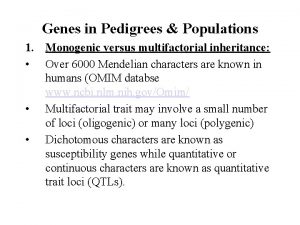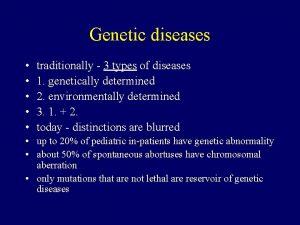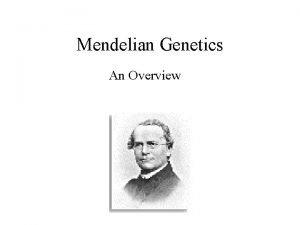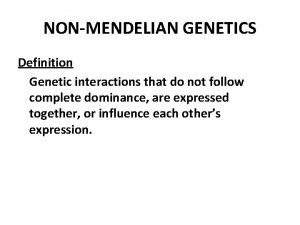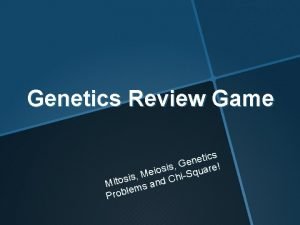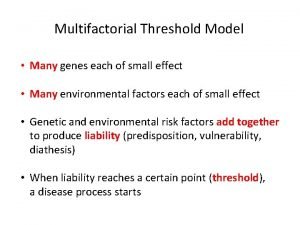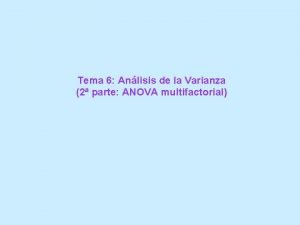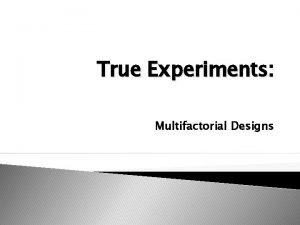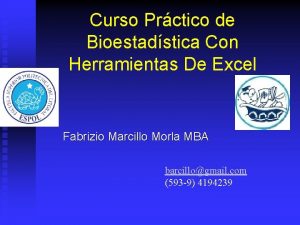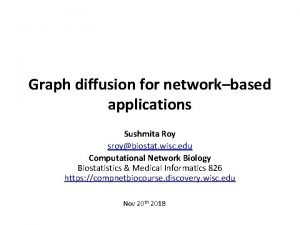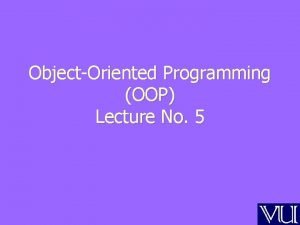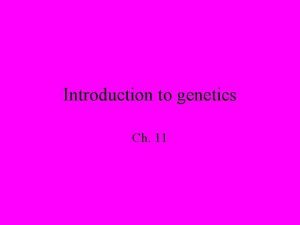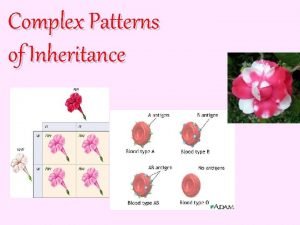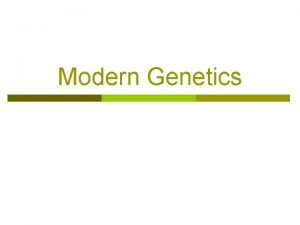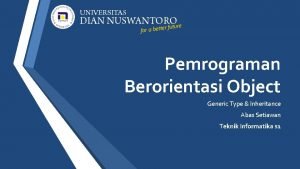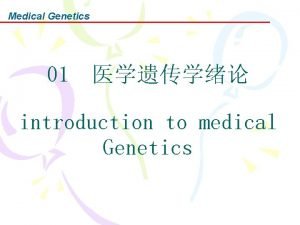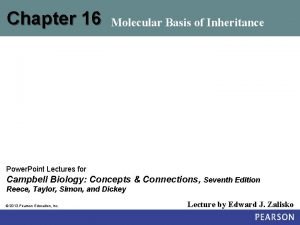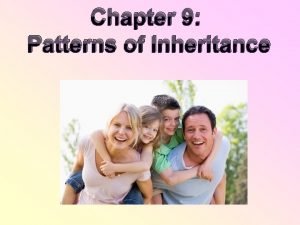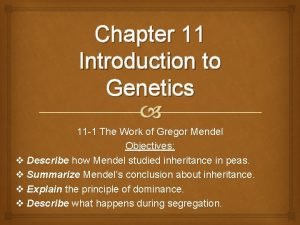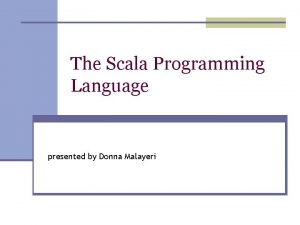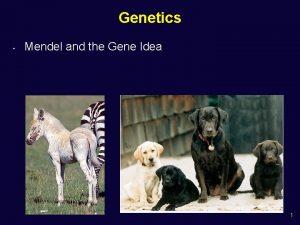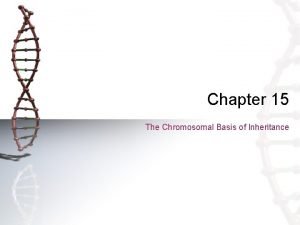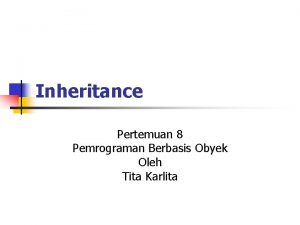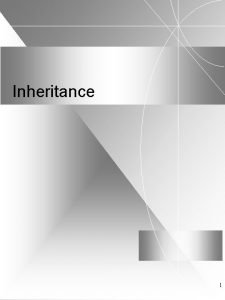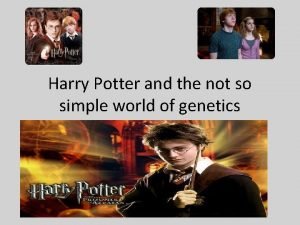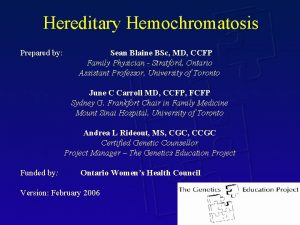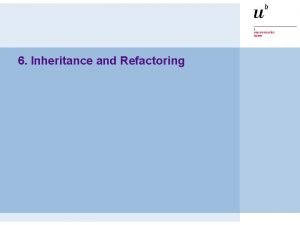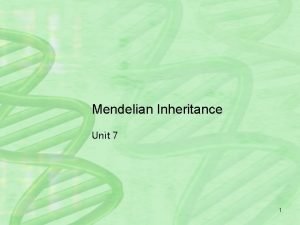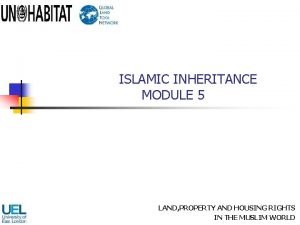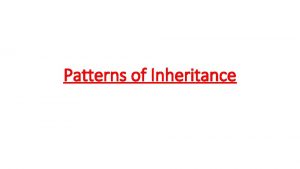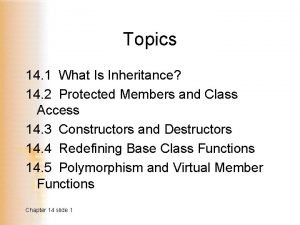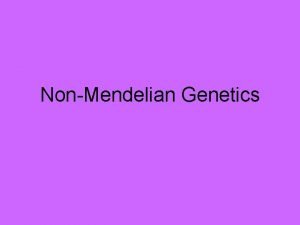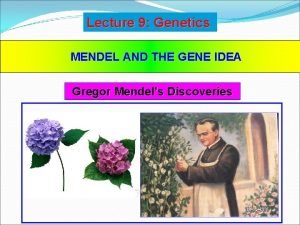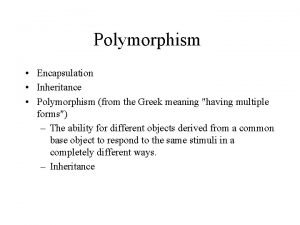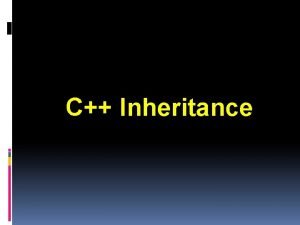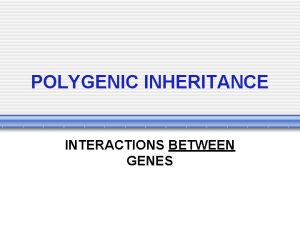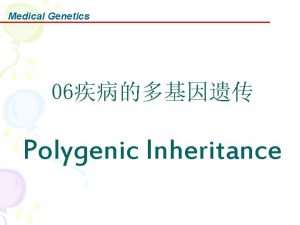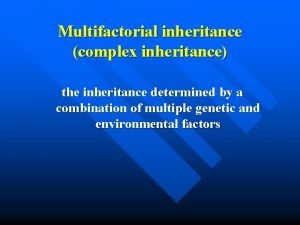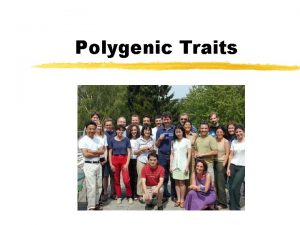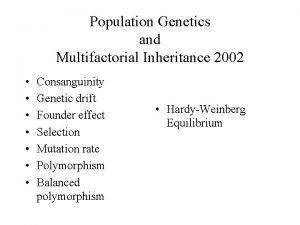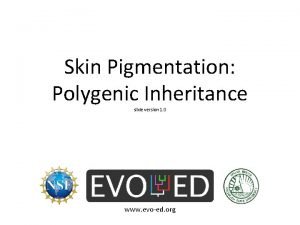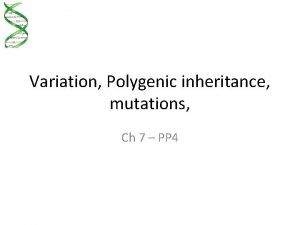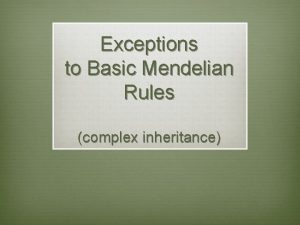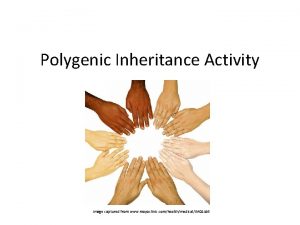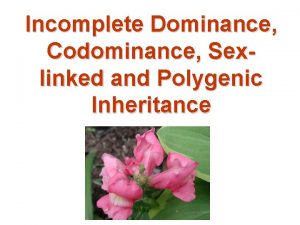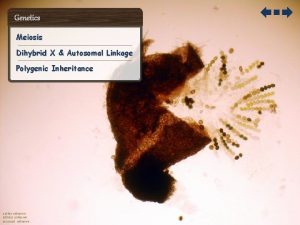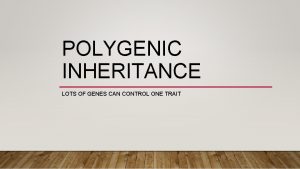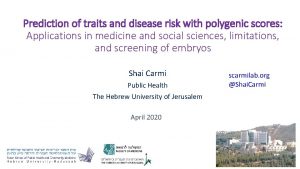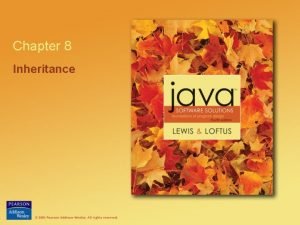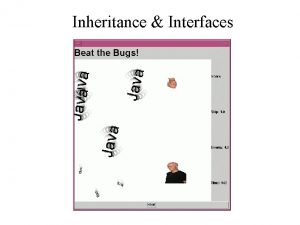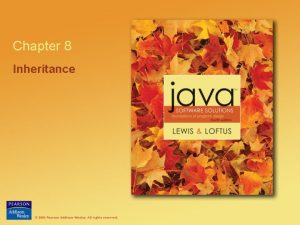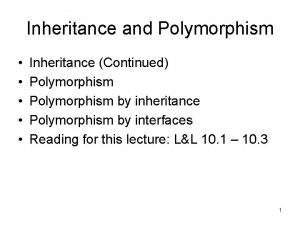Nuclear3 Polygenic Inheritance Polygenic inheritance Polygenic disease multifactorial










































- Slides: 42

Nuclear-3 Polygenic Inheritance

{ Polygenic inheritance { Polygenic disease (multifactorial disease) { Characteristics { recurrence risk

11. 1 Polygenic inheritance Minor gene Genetic factor codominance Additive effect Environmental factor

2. Polygenic Inheritance v Several loci are involved in the expression of the trait. v There is no dominance or recessive at each of these loci. v The loci act in concert in an additive fashion, each adding or detracting a small amount from the phenotype. v The environment interacts with the genotype to produce the final phenotype.

1. Qualitative traits vs. quantitative traits v Qualitative traits (Discontinuous traits) - each trait has two, or a few, very different unambiguous states v Quantitative traits (Continuous traits) - each trait has numerous slightly different variants



Normal distribution • Symmetric, “bell-shaped” curve • 95% of values lie within 2 standard deviations of mean • Many quantitative traits are distributed “normally”

Birth weights of babies born to teenagers in Portland, Oregon in 1992.


5000 British women

A’A’B’B’C’ C’ AABBCC × AA’BB’C C’ A’BC AB’C ABC’ × A’B’C AA’BB’C C’ A’BC’ AB’C’ A’B’C ’ AA’BBCC AABB’CC AABBCC’ AA’BB’CC AA’BBCC’ AABB’CC’ AA’BB’CC’ ABC AABBCC A’BC AA’BBCC A’A’BBCC AA’BB’CC AA’BBCC’ A’A’BB’CC A’A’BBCC’ AA’BB’CC’ A’A’BB’CC’ AB’C AABB’CC AA’BB’CC AAB’B’CC AABB’CC’ AA’B’B’CC AA’BB’CC’ AAB’B’CC’ AA’B’B’CC’ ABC’ AABBCC’ AA’BBCC’ AABB’CC’ AABBC’C’ AA’BB’CC’ AA’BBC’C’ AABB’C’C’ AA’BB’C’C’ A’B’C AA’BB’CC A’A’BB’CC AA’B’B’CC AA’BB’CC’ A’A’B’B’C A’A’BB’CC AA’B’B’CCA’A’B’B’CC ’ ’ C ’ A’BC’ AA’BBCC’ A’A’BBCC’ AA’BB’CC’ AA’BBC’C’ A’A’BB’CC A’A’BBC’C AA’BB’C’CA’A’BB’C’C ’ ’ AB’C’ AABB’CC’ AA’BB’CC’ AAB’B’CC’ AABB’C’C’ AA’B’B’CC AA’BB’C’C AAB’B’C’CAA’B’B’C’C ’ ’ A’B’C’ AA’BB’CC’ A’A’BB’CC AA’B’B’CC AA’BB’C’C A’A’B’B’C A’A’BB’C’ AA’B’B’C’ A’A’B’B’C’ ’ C’ C’

Skin pigmentation


Polygenic Inheritance Homozygous parental pops. - still show some environmental variation F 1 - intermediate shows some variability (environmental) F 2 - much greater variability - mean is intermediate genetic + envir.

Genes and Disease Environmental Diseases Monogenic Diseases Complex Diseases l Huntington Disease l Alzheimer disease l Influenza l Cardiovascular Disease l Hepatitis l Spinocerebellar Ataxia l Spastic Paraplegia l Tuberous Sclerosis l Autism l Measles l Parkinson Disease - Environment - Genes

11. 2 Polygenic diseases v Common malformation or diseases, PF >0. 1% v Tend to aggregate in families, but the recurrence risks in families often fall in the range of 1% to 10% v Resulted from an interaction between multiple genes and often multiple environmental factors

Polygenic Disorders v Congenital Malformations cleft lip / palate 唇腭裂 congenital dislocation of the hip 先天性髋关节脱位 congenital heart defects 先天性心脏缺陷 neural tube defects 神经管缺陷 pyloric stenosis 幽门狭窄 talipes 畸形足 congenital megacolon 先天性巨结肠 v Adult Onset Diseases diabetes mellitus 糖尿病 epilepsy 癫痫 glaucoma 青光眼 hypertension 高血压 Schizophrenia 精神分裂症

congenital megacolon Congenital Dislocation of Hip Joint neural tube defects cleft lip / palate

1. How to study polygenic disorders? Liability of polygenic disorder is determined by genetic and environmental factors simultaneously; Susceptibility is determined by the genetic basis of a certain polygenic disorder; Threshold model is a useful tool for our research on polygenetic disorders.

2. Threshold model v A threshold model has often been proposed as a way to explain the inheritance patterns of multifactorial conditions. In this model, there is a continuous distribution of a genetically determined liability for a given condition, but only some proportion of individuals above a certain threshold of genetic liability will develop the condition, especially if exposed to environmental factors that can trigger the development of the trait.

Threshold model The threshold model for multifactorial traits. Below the threshold the trait is not expressed. Individuals above threshold have the disease.

Threshold model v v The curve for relatives is shifted to the right compared to the general population. The closer the relationship the greater the shift to the right.

3. Heritability Phenotypic variance Genetic Environmental variance VP = V G + V E v Heritability-- Fraction of the phenotypic variance due to genetic effects h 2=VG / Vp

Heritability v v H=1 genes only H=0 environment only Trait Clubfoot Height Blood pressure Heritability 0. 8 0. 6 Body mass Verbal aptitude Math aptitude Spelling aptitude Fingerprint ridge count Intelligence Total serum cholesterol 0. 5 0. 7 0. 3 0. 5 0. 9 0. 5 -0. 8 0. 6

Coefficient of Relationship (r) v the proportion of all genes in two individuals which are identical by descent. A C E A(B) –C(D) : r = 1/2 B D F How about C & D?

Coefficient of Relationship (r) r=1/2 1 st degree (parent, sib, child) r=1/4 2 nd degree (uncle, niece, grandchild) r=1/8 3 rd degree (first cousin, great-grand) r=1/2 r=1/4 r=1/8 r=1/4

4. Characteristics of Polygenic diseases v The incidence of the condition is greater in relatives of the affected individuals than that in general population, but much less than 25%. v The risk is same among the same degree relatives. v The risk is greatest for the first degree relatives and decreases rapidly in more distant relatives. v Consanguinity slightly increases the probability of an affected child for a polygenic disorder.

5. Estimating Recurrence Risk v For single gene diseases, the recurrence risk is easy to calculate. v For polygenic diseases, the recurrence risk must be derived empirically (i. e. from observations in large samples).

Estimate of Recurrence Risk Ø Edward formula Incidence ≈ 0. 1%~ 1% Heritability ≈ 70%~ 80% f = P Incidence of first degree relative (%) 40 20 10 100 8 90 6 80 4 70 60 2 50 1 40 0. 8 30 0. 6 20 0. 4 10 0. 2 0 0. 1 0. 2 0. 4 0. 6 0. 8 1 2 4 6 8 10 Incidence of population (%)

Recurrence risks v If p is the frequency of a polygenic disease in the population, the risk for first degree related individuals is approximately the square root of p (PF 0. 1%-1%; h 2 70 -80%) e. g. Cleft palate, PF=0. 16%, h 2=76% ? ? RR=4%

Recurrence risks Empiric risk of cleft palate Relationship General population Recurrence Risk 0. 1% First cousin 0. 3% Niece or nephew 0. 8% Child 3. 5% Sibling 4. 1% Identical twin 40. 0%

threshold G Ⅲ Ⅱ Ⅰ liability

Recurrence risks v Increase with the number of affected relatives ? Family A RR Family A ? ? Family C Family B < Family C

Recurrence Risk for Cleft Lip Depends on Family History No. of Parents Affected No. of Siblings Affected 0 1 2 0. 1 3 8 3 11 19 34 40 45

Recurrence risks v Increase with the severity of the condition In multifactorial traits, the more severely affected the individual, the more genes he/she has to transmit, and the higher the recurrence risk.

TWO THRESHOLD DISEASES v In many multifactorial diseases the two sexes have different probabilities of being affected. For example, pyloric stenosis occurs in about 1/200 newborn males but only in about 1/1000 newborn females. This means that there is a double threshold, one for females and one for males, with the female threshold farther from the mean that for the male. However, since it takes more deleterious genes to create an affected female, she has more genes to pass on to the next generation. Her male offspring are at a relative high risk of being affected when compared to the population risk.

TWO THRESHOLD DISEASES Threshold for males Threshold for females liability


Recurrence risks - pyloric stenosis ? Family A ? Family B RR: Family A < Family B

Recurrence risks – congenital dislocation of the hip

Hallmarks for Polygenic Diseases v Most affected children have normal parents. v Recurrence risk increases with the number of affected children in a family. Recurrence risk increases with severity of the defect. Consanguinity slightly increases the risk for an affected child. v v v Risk of affected relatives falls off very quickly with the degree of relationship. v If the two sexes have a different probability of being affected, the least likely sex, if affected, is the most likely sex to produce an affected offspring.
 Limnked
Limnked Multifactorial inheritance.
Multifactorial inheritance. Polygenic inheritance
Polygenic inheritance Pleiotropism definition
Pleiotropism definition Polygenic inheritance
Polygenic inheritance Polygenic inheritance
Polygenic inheritance Multifactorial threshold model
Multifactorial threshold model Ve
Ve Between subjects factorial design
Between subjects factorial design Asumción
Asumción Palin pci training
Palin pci training Butrwr
Butrwr Bharathi viswanathan
Bharathi viswanathan Mendelian genetics
Mendelian genetics Oop
Oop Mendel's first and second law of inheritance
Mendel's first and second law of inheritance Spanish inheritance tax valencia region
Spanish inheritance tax valencia region Complex patterns of inheritance
Complex patterns of inheritance Sex linkage
Sex linkage Modern genetics human inheritance answer key
Modern genetics human inheritance answer key Apa itu method
Apa itu method Genetics
Genetics Proverbs 13 1
Proverbs 13 1 Ppt molecular basis of inheritance
Ppt molecular basis of inheritance Chapter 9 patterns of inheritance
Chapter 9 patterns of inheritance What did mendel conclude determines biological inheritance
What did mendel conclude determines biological inheritance Donna malayeri
Donna malayeri Dominant or recessive
Dominant or recessive Chapter 15: the chromosomal basis of inheritance
Chapter 15: the chromosomal basis of inheritance Contoh multilevel inheritance
Contoh multilevel inheritance Private inheritance
Private inheritance Sex cat
Sex cat Sean blaine
Sean blaine Inheritance board game
Inheritance board game Difference between mendelian and non mendelian inheritance
Difference between mendelian and non mendelian inheritance Inheritance in islam
Inheritance in islam Complete dominance pattern of inheritance
Complete dominance pattern of inheritance What is inheritance
What is inheritance Non mendelian inheritance
Non mendelian inheritance Cystic fibrosis mendelian inheritance
Cystic fibrosis mendelian inheritance Encapsulation inheritance polymorphism
Encapsulation inheritance polymorphism Sex linked punnet
Sex linked punnet C++ advantages
C++ advantages
